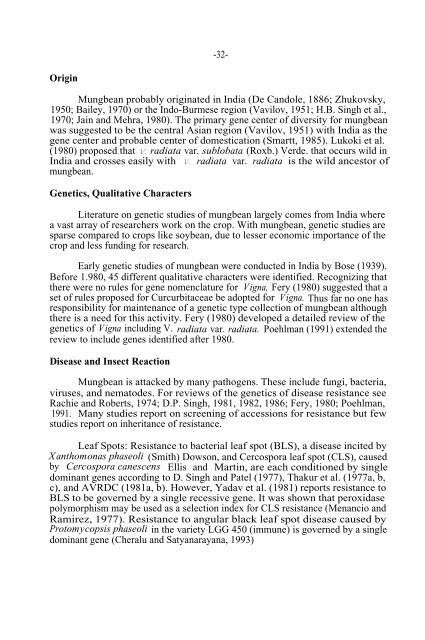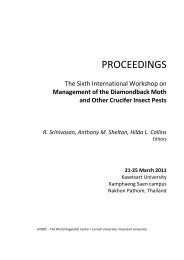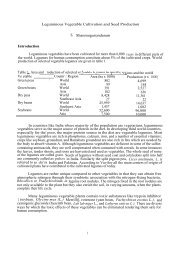MUNGBEAN VARIETAL IMPROVEMENT S. Shanmugasundaram
MUNGBEAN VARIETAL IMPROVEMENT S. Shanmugasundaram
MUNGBEAN VARIETAL IMPROVEMENT S. Shanmugasundaram
Create successful ePaper yourself
Turn your PDF publications into a flip-book with our unique Google optimized e-Paper software.
-32-<br />
Origin<br />
Mungbean probably originated in India (De Candole, 1886; Zhukovsky,<br />
1950; Bailey, 1970) or the Indo-Burmese region (Vavilov, 1951; H.B. Singh et al.,<br />
1970; Jain and Mehra, 1980). The primary gene center of diversity for mungbean<br />
was suggested to be the central Asian region (Vavilov, 1951) with India as the<br />
gene center and probable center of domestication (Smartt, 1985). Lukoki et al.<br />
(1980) proposed that V. radiata var. sublobata (Roxb.) Verde. that occurs wild in<br />
India and crosses easily with V. radiata var. radiata is the wild ancestor of<br />
mungbean.<br />
Genetics, Qualitative Characters<br />
Literature on genetic studies of mungbean largely comes from India where<br />
a vast array of researchers work on the crop. With mungbean, genetic studies are<br />
sparse compared to crops like soybean, due to lesser economic importance of the<br />
crop and less funding for research.<br />
Early genetic studies of mungbean were conducted in India by Bose (1939).<br />
Before 1.980, 45 different qualitative characters were identified. Recognizing that<br />
there were no rules for gene nomenclature for Vigna, Fery (1980) suggested that a<br />
set of rules proposed for Curcurbitaceae be adopted for Vigna. Thus far no one has<br />
responsibility for maintenance of a genetic type collection of mungbean although<br />
there is a need for this activity. Fery (1980) developed a detailed review of the<br />
genetics of Vigna including V. radiata var. radiata. Poehlman (1991) extended the<br />
review to include genes identified after 1980.<br />
Disease and Insect Reaction<br />
Mungbean is attacked by many pathogens. These include fungi, bacteria,<br />
viruses, and nematodes. For reviews of the genetics of disease resistance see<br />
Rachie and Roberts, 1974; D.P. Singh, 1981, 1982, 1986; Fery, 1980; Poehlman,<br />
1991. Many studies report on screening of accessions for resistance but few<br />
studies report on inheritance of resistance.<br />
Leaf Spots: Resistance to bacterial leaf spot (BLS), a disease incited by<br />
Xanthomonas phaseoli (Smith) Dowson, and Cercospora leaf spot (CLS), caused<br />
by Cercospora canescens Ellis and Martin, are each conditioned by single<br />
dominant genes according to D. Singh and Patel (1977), Thakur et al. (1977a, b,<br />
c), and AVRDC (1981a, b). However, Yadav et al. (1981) reports resistance to<br />
BLS to be governed by a single recessive gene. It was shown that peroxidase<br />
polymorphism may be used as a selection index for CLS resistance (Menancio and<br />
Ramirez, 1977). Resistance to angular black leaf spot disease caused by<br />
Protomycopsis phaseoli in the variety LGG 450 (immune) is governed by a single<br />
dominant gene (Cheralu and Satyanarayana, 1993)

















